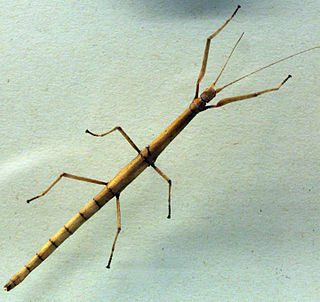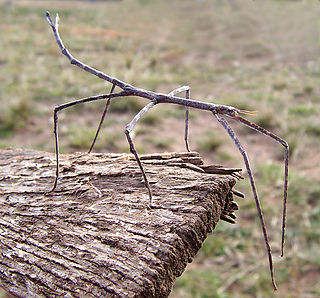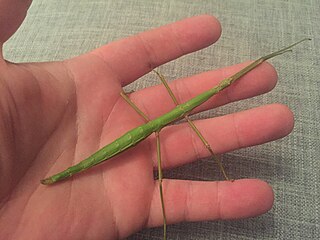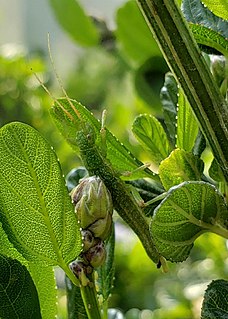
Asexual reproduction is a type of reproduction that does not involve the fusion of gametes or change in the number of chromosomes. The offspring that arise by asexual reproduction from either unicellular or multicellular organisms inherit the full set of genes of their single parent. Asexual reproduction is the primary form of reproduction for single-celled organisms such as archaea and bacteria. Many eukaryotic organisms including plants, animals, and fungi can also reproduce asexually. In vertebrates, the most common form of asexual reproduction is parthenogenesis, which is typically used as an alternative to sexual reproduction in times when reproductive opportunities are limited.

The Phasmatodea are an order of insects whose members are variously known as stick insects, stick-bugs, walking sticks, or bug sticks. They are generally referred to as phasmatodeans, phasmids, or ghost insects. Phasmids in the family Phylliidae are called leaf insects, leaf-bugs, walking leaves, or bug leaves. The group's name is derived from the Ancient Greek φάσμα phasma, meaning an apparition or phantom, referring to their resemblance to vegetation while in fact being animals. Their natural camouflage makes them difficult for predators to detect; still, many species have one of several secondary lines of defence in the form of startle displays, spines or toxic secretions. Stick insects from the genera Phryganistria, Ctenomorpha, and Phobaeticus includes the world's longest insects.

Parthenogenesis is a natural form of asexual reproduction in which growth and development of embryos occur without fertilization by sperm. In animals, parthenogenesis means development of an embryo from an unfertilized egg cell. In plants parthenogenesis is a component process of apomixis.

Carausius morosus is a species of Phasmatodea (phasmid) often kept as pets by schools and individuals. Culture stocks originate from a collection from Tamil Nadu, India. Like the majority of the Phasmatodea, C. morosus are nocturnal. Culture stocks are parthenogenetic females that can reproduce without mating. There are no reports of males, although in captivity, gynandromorphs are sometimes reared.

Timema is a genus of relatively short-bodied, stout stick insects native to the far western United States, and the sole extant member of the family Timematidae. The genus was first described in 1895 by Samuel Hubbard Scudder, based on observations of the species Timema californicum.

Argosarchus is a monotypic genus in the family Phasmatidae containing the single species Argosarchus horridus, or the New Zealand bristly stick insect, a stick insect endemic to New Zealand. The name "horridus" means bristly in Latin, likely referring to its spiny thorax.

Ctenomorpha marginipennis, the margin-winged stick insect, is a species of stick insect endemic to southern Australia. The species was first described by George Robert Gray in 1833.

Mantises are an order (Mantodea) of insects that contains over 2,400 species in about 460 genera in 33 families. The largest family is the Mantidae ("mantids"). Mantises are distributed worldwide in temperate and tropical habitats. They have triangular heads with bulging eyes supported on flexible necks. Their elongated bodies may or may not have wings, but all Mantodea have forelegs that are greatly enlarged and adapted for catching and gripping prey; their upright posture, while remaining stationary with forearms folded, has led to the common name praying mantis.

Clitarchus hookeri, is a stick insect of the family Phasmatidae, endemic to New Zealand. It is possibly New Zealand's most common stick insect. Clitarchus hookeri is often green in appearance, but can also be brown or red. Alongside the prickly stick insect and the Unarmed stick insect, C. hookeri is one of three stick insect species to have become naturalised in Great Britain, with all three having originated in New Zealand.

Acanthoxyla is a genus of stick insects in the family Phasmatidae. All the individuals of the species are female and reproduce asexually by parthenogenesis. However, a male Acanthoxyla inermis was recently discovered in the UK, probably the result of chromosome loss. The genus is the result of interspecific hybridisation resulting in some triploid lineages and some diploid lineages. The genus is endemic to New Zealand, but some species have been accidentally introduced elsewhere. The genus name Acanthoxyla translates from Greek as prickly stick.

Acanthoxyla inermis is an insect that was described by John Tenison Salmon 1955. Acanthoxyla inermis is included in the genus Acanthoxyla, and family Phasmatidae. No subspecies are listed. This species is native to New Zealand but has been unintentionally moved to Great Britain where it has grown a stable population and is the longest insect observed, and the most common of the stick insects that have established themselves on the island.

Timema poppense, the "Pope Valley timema", is a species of walkingstick in the family Timematidae. It is found in California, and originally described from a nature reserve in the Pope Valley.

Timema bartmani, or Bartman's timema, is a species of stick insect in the family Timematidae. It is found in North America.

Timema cristinae, or Cristina's Timema, is a species of walking stick in the family Timematidae. This species is named in recognition of the person who first found and collected it, Cristina Sandoval. It is found in North America, in a small region of southern California, US. T. cristinae is one of the smallest species of stick insects. They are flightless, and feed on the shrubs on which they live.

Timema knulli, Knull's Timema, is a stick insect native to California.

Timema shepardi, Shepard's Timema, is a stick insect native to northern California. It was first identified in 1999. It is one of five parthenogenetic species of Timema.
Tanja Schwander is a Swiss evolutionary biologist and professor at the University of Lausanne. She is known for her work on the Evolution of sexual reproduction.

Aretaon is a genus of stick insects native to Borneo and the Philippine island Palawan.

Orestes mouhotii is an insect species belonging to the order of Phasmatodea. Because of its synyonym Orestes verruculatus, it is the type species of the genus Orestes. Because of its compact body shape, the species is sometimes referred to as small cigar stick insect.

Timema monikense is a parthenogenetic stick insect native to California.



















